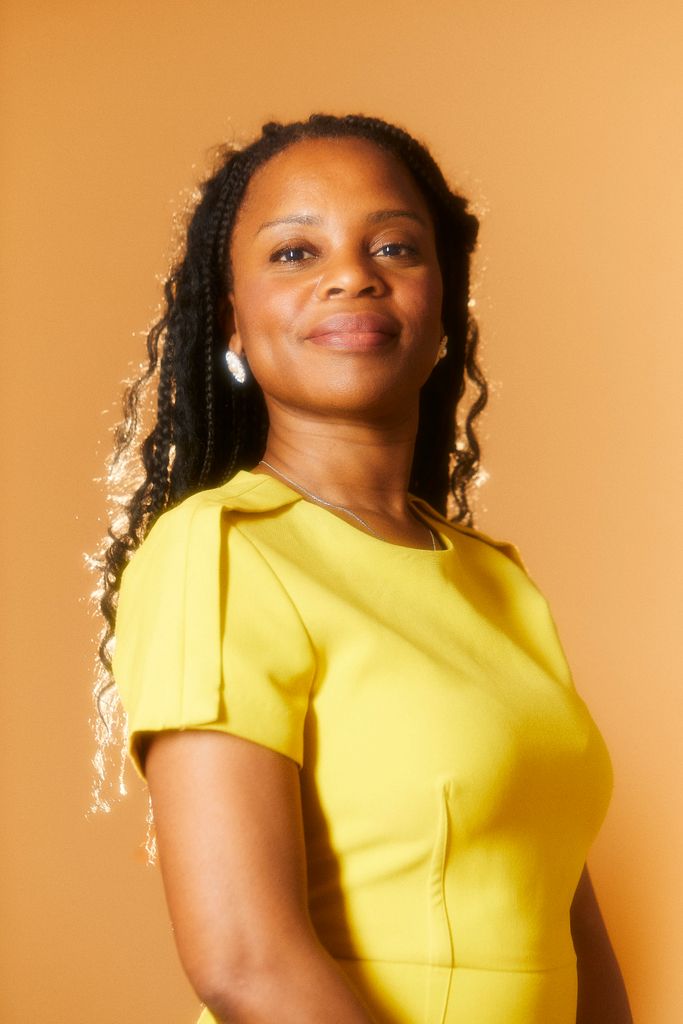Inspiration for Change

Photos by Ciara Crocker
Inspiration for Change
Advice from Kenann McKenzie, director of the Aspire Institute, a BU Wheelock–based professional development nonprofit, on building community, supporting teacher well-being, and tackling racism
Kenann McKenzie was seven years old when she immigrated to the United States from Guyana. She enjoyed learning. So did her mother, who was working toward an undergraduate degree. But when McKenzie tried to enroll in a New York City public school, she was told she’d be held back a grade.
It had nothing to do with how smart she was, how eager she was to learn. McKenzie was a Caribbean immigrant and, she was told, those were just the rules for people like her.
“Coming from what people call a third world country, coming out of a situation where we materially didn’t have a lot, people make assumptions about what you have and what you’re capable of,” says McKenzie, whose mother ended up enrolling her in a private school for her first years in the States—a “telling sacrifice”—to ensure she was treated with fairness. “I just loved school and that continued throughout my life. Even when I started to encounter racism that was blatant as I was older, it didn’t shake my feeling about who I was.”

She calls that early school experience her “biggest why”—the reason she became an educator. It’s also why she’s so focused on giving others the resources and training they need to ensure “all children are cherished and encouraged to be the best they could be.”
McKenzie is director of the Aspire Institute, a BU Wheelock–based nonprofit that provides professional development for teachers and administrators, project and training support for schools, districts, and states, and access to mentors for newly qualified teachers. A longtime K–12 and higher education administrator and researcher, McKenzie was formerly executive director of the National Board of Education Sciences. “I want to help disabuse people of this idea that they can look at somebody and write them off.”
Founded in 2007 as part of the former Wheelock College, the Aspire Institute has a mission “to advance knowledge and solutions in response to social and educational challenges.” Recent projects have included hosting monthly self-care groups for educators, seminars on school reopenings and equity, and a forum on trauma and resilience.
Much of the institute’s work, which is funded by grants, philanthropic support, and project revenues, is centered on Boston.
“We are in an interplay of support with our community,” says McKenzie. “At BU Wheelock, we’re collectively looking at how to make education a transformative space, and I do not think you can do that unless you’re in the community itself.”
While the Aspire Institute acts as a venue for sharing BU expertise with the city, it also serves as a conduit for local knowledge.
“When I’m spending time with principals, in schools, and with teachers, there’s so much that I am learning,” says McKenzie, an adjunct assistant professor. “We need the input to know what really matters to people around us—what do they know, what do they have to teach us? We can’t know that if we’re in a bubble.
“When I’m teaching my students, I’m giving them real-world examples that are timely, current, and place-based. I can say, ‘I’m in schools, this is what I’m seeing.’”
In the past year, many of the requests to the institute for support have been tied to the pandemic and social and political events: about building community, fighting racism, and promoting student and teacher well-being. BU Wheelock asked McKenzie to share some Aspire Institute–inspired lessons and advice:
1. Get to know your community
Like many other educators, McKenzie always believed that schools had a role in fostering community—within their walls and beyond—but she says the pandemic underlined its importance.
“What we have learned about our places of learning is that they are a community for children, and we know children value connecting with other adults and children,” she says. “Building a sense of community is urgent and necessary—something to really spend time on.”
But she admits it’s difficult to start engaging in that work if staff are already overloaded or if a school doesn’t fully understand the needs and issues of its children and neighbors.
“Many schools make a good effort, but it’s not just about your effort, it’s about knowing the right strategies for your school community,” says McKenzie. “And that takes getting to know the community, building relationships.”
She says formal surveys and informal conversations with residents can be a good way to figure out local interests and needs—and ways the school might be able to help. At one high school she worked at, McKenzie and other administrators opened a food pantry on parent-teacher conference days in response to neighborhood food scarcity. “Engaging families on-site,” she says, “also helps to better understand the context within which students are seeking to thrive.”
2. Partner with families
According to multiple studies, involving parents in their kids’ education has a cascading effect beyond building community: children do better at school and at home, teacher morale goes up, school academic and social ratings improve.
But, in a 2020 survey of teachers and parents, the Center for American Progress found that while many schools do a good job of working with parents, the connection often drops during middle school. Many families also said schools weren’t communicating frequently or consistently enough.
McKenzie recommends not only personalizing messages, communicating in languages parents speak, and showing how feedback has led to changes, but also thinking beyond the standard emails and newsletters.
“We have to be creative about how we reach out to families,” she says.
During her time teaching in Washington, D.C., McKenzie prompted family engagement in important events by mixing in student-led displays and entertainment. “Whenever we had students centered in the activity, parents showed up.” A community forum on equity, for example, featured the marching band and cheerleading squad. “We had a full gym. Part of that is just understanding what parents value. You can incorporate other things they need to know within that setting.”
3. Have a North Star
Everyone has a bad day—perhaps more than one or two in the last year or so. To counteract the tough moments, McKenzie recommends teachers “find the North Star that wakes them up every day, that helps them refocus their attention on why they went into the profession.” She says journaling can be a way to affirm that: marking the positive interactions, the inspirational lessons.
Although educators worry about the mental health of their students, McKenzie says too few take care of their own well-being.
“As we practice that for ourselves and model it, then we are able to be better at sharing it with other people,” she says. “We need as much encouragement and reinforcement of positive things. And it always helps to reflect on whether there’s something you’re going to do differently tomorrow.”
4. Check your biases
“Had somebody shared the demographics of my birth,” says McKenzie, “the predictors would have been all negative—they would have said all sorts of things weren’t going to be possible. We need to work toward a future where your zip code or skin color or language should not be such a great predictor of your life chances.”
Since the murder of George Floyd, many institutions have stepped up their efforts to tackle racism and make themselves more equitable—and plenty have turned to the Aspire Institute for help finding their blind spots or building inclusive policies. While McKenzie lauds those schools that have started antiracism work alone, she says bringing in outside experts can allow for deeper—and more necessarily critical—conversations.
“Had somebody shared the demographics of my birth, the predictors would have been all negative—they would have said all sorts of things weren’t going to be possible. We need to work toward a future where your zip code or skin color or language should not be such a great predictor of your life chances.”—Kenann McKenzie
“The sharing isn’t quite the same when your school leader is asking you,” she says. “The power dynamics that existed in the building could impact the way people share and how comfortable they feel divulging their concerns.”
It also prevents the work, which McKenzie says shouldn’t just be a one-off workshop, becoming a burden or an add-on that keeps getting postponed.
“We have to keep being self-aware of how our actions and our thinking could be limiting what it is we’re giving to children,” she says. “We have to be able to peel away those layers of the biases we hold.”
Schools can do all kinds of work to direct resources to give all children what they need to be successful, she says, but “we have to start off believing they can be successful.”
5. Let kids be kids
A global pandemic, systemic racism, fractured politics. “Our children have been surrounded by a lot of social upheaval,” says McKenzie. And while she wants educators to engage children in these big topics in age-appropriate ways, McKenzie also hopes they’ll remember to give kids a chance to be, well, kids.
“Our best moment is when we can see children for who they are and that we appreciate that childhood is not something to race through, not a bump in the road to adulthood,” says McKenzie. Children love to play, explore their curiosity. “Childhood has to be celebrated and honored.”